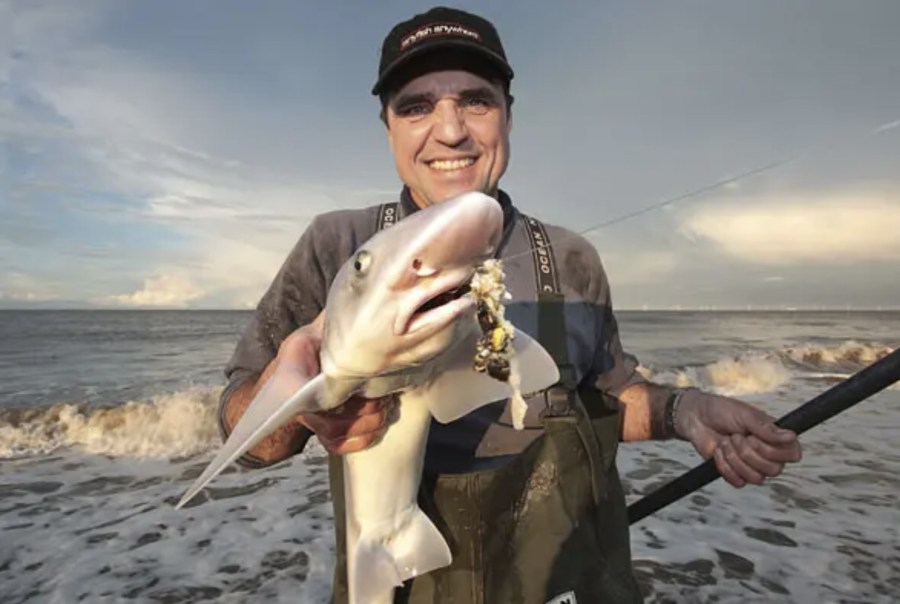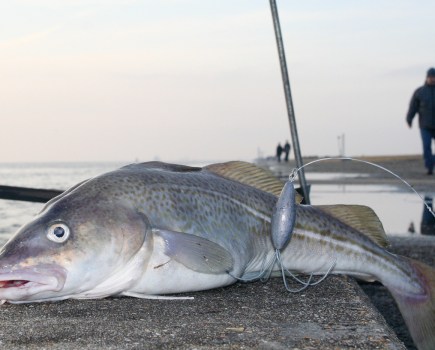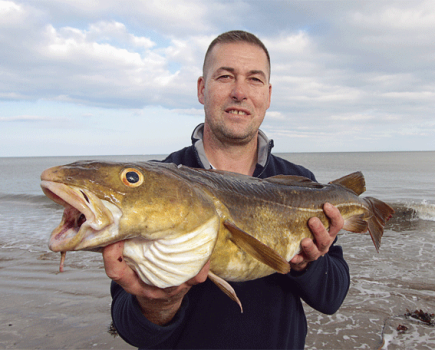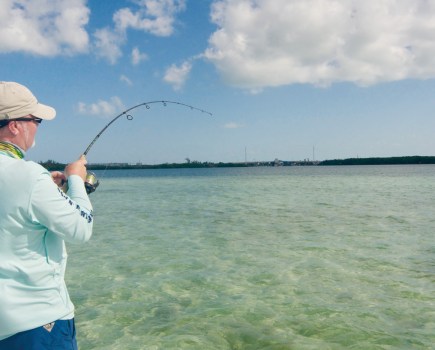Why do you choose a particular pattern or size of hook? Is it the one your dealer sells the most of, is it the cheapest, are you a sucker for the adverts or does your mate use it?
There are plenty of other just as silly reasons why a particular hook pattern gains favour and there are also lots of sea anglers using hook patterns that should have stayed in the Ark.
The big breakthrough in hook making came when a chemical process, like the way coins are coated, was introduced, instead of the old method of tumbling hooks in a vat of enamel to coat them.
This led to today’s term of ‘chemical sharpening’ or ‘chemical etching’ because the result is a far sharper hook point. One of the reasons hook points are sharper is because the old tumbling process actually dulled the vital point area. The chemical coating process keeps the hook as sharp as when it was first produced.
So rule number one is to use only chemically etched hooks because they are so much sharper than any others. Don’t believe me? Try this simple hook test – will your hook point dig into your thumbnail when you draw the point over it? A chemically etched hook will dig in every time and if yours don’t, bin them and get down the tackle dealers.
Patterns and designs
There are so many hook patterns available because we are not all the same and anglers have personal preferences, and it’s a human trait to have an individual opinion on everything, especially fishing gear.
Several lifetimes of anglers – whether coarse, game, sea or commercial – have produced hundreds of hook designs and patterns. Some are for a particular species, some for a particular bait, some are known by their shape, the name of the designer or place they came from, and others are a pattern designed by the professional fisherman.
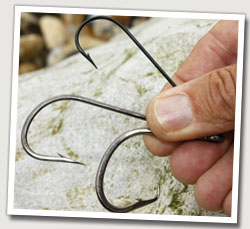 Thankfully in recent years several of the major hook brand ranges have been consolidated, with around six patterns reckoned to cover most sea angling options.
Thankfully in recent years several of the major hook brand ranges have been consolidated, with around six patterns reckoned to cover most sea angling options.
What are the best makes? Ask any angler and he will have an opinion. Mine is that Japanese/ American hooks are mostly the best with my favourite makes including Kamasan and Owner.
UNDERSTAND HOOK SIZES Remember, large numbers mean small hooks
Hook sizes are not complicated. The higher the hook size number means the smaller the hook. The addition of a slash and zero, /0, to the larger hook sizes could lead to confusion.
Sizes 24, 22, 20 descending are the tiniest freshwater fishing size. The sea range starts at around size 8; 6; 4; 2 and gets bigger down to a size 1. Once the 1 is reached the /0 is added as the size increases as the number increases from 1/0, 2/0, 3/0, 4/0 and up to a 12/0, which is the largest big-game hook.
Hook sizes are supposed to be standard, but in reality they are not and the various manufacturers have their own interpretation of sizes.
HOOK SIZE AND SPECIES FORMULA Here is a rough guide of hook size in relation to fish species
– Size 4 and 6: Suitable for small species with tiny mouths like mullet, sole, bream and garfish.
– Size 2, 1, 1/0: The standard sizes for shore fishing for the smaller common species like dogfish, wrasse, pouting, whiting, codling, dabs, flounders, plaice etc.
– Size 1/0, 2/0 and 3/0: The choice for larger species like cod, bass, pollack, rays and smoothhounds.
– Size 4/0, 5/0, 6/0: Essential for the biggest species, such as conger eels, big cod or bass and for use with very large baits like whole squid and mackerel.
– Size 6/0 and above: Required for sharks and big-game fish.
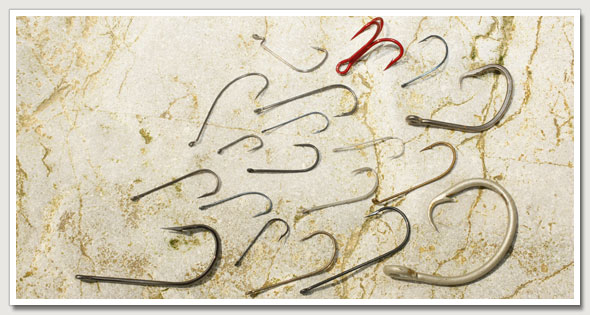
FAVOURITE PATTERNS What they are and what they’re for
Aberdeen: The all-round favourite shore and boat hook for worm baits. Sometimes also called worm hooks, they are available in most sizes. One of the best is the Kamasan B940
Uptide or Viking: Arock angling and uptiding favourite for use with big baits, especially peeler and hermit crabs for the bigger species like bass and smoothhounds. Mustad and Kamasan are among the favourites.
Beaked: Aclassic blast from the past, the bent in beaked point still has its fans, but Iwouldn’t tie one on your snood, let alone mine. Only the Kamasan K60 impresses me.
Crab hooks: Popular patterns of the past include the Limerick style short shank. The Kamasan B900Cis similar, while the B940Sis a popular short shank version of the Kamasan Aberdeen.
O’Shaughnessy: This is a heavy-duty forged pattern renowned for its strength and is generally available in the large sizes for big fish. Ideal for a whole mackerel head or flapper, double squid or large spider peeler. Meat hooks from Cox & Rawle and Kong hooks from Hiro are just a couple of the other strong patterns available for big fish.
Bait holders: Retaining barbs sit along the shank to support the bait – a great idea but they do enable the bait to travel up the snood and not down around the point, which can be a pain when fishing for the smaller species. Elastic cotton is particularly difficult to remove from them.
Match hook: Generally a light fine-wire pattern, such as the Mustad Nordic bend 446Bor the Mustad 3262 blue Aberdeen. Avoid both if you want to land fish weighing more than 1lb.
Semi-circles: The semi-circle hook or smart hook has grown in popularity in recent times, particularly for livebaiting. Its turned in point is a better choice than beaked hooks.
BE WISE WHEN BUYING It pays to buy in bulk, but avoid cheap deals
Hooks are generally available in packs of six, 10, 12 and 25 or in boxes of 50 or 100, although lots of distributors realise there is more profit in small packs.
Cheap hooks sold on the Internet may appear a bargain, but is it wise to scrimp on hooks?
SHANK AND GAPE
– The shank of hooks varies in length and wire thickness and this usually relates to the hook’s suitability for a particular bait or species.
Aberdeens have a longer shank and are suitable for worms and sandeels. O’Shaughnessy hooks are considered large and strong and are favoured for species like conger eels.
The gape is the distance from the shank to the point, which relates to the size of the hook. However, some patterns of a different size have a similar gape, but are of a difference thickness of wire. This allows the angler to choose a lighter, bendier hook for catch and release or fishing snaggy ground so that the hook springs out.
Bass anglers fishing with a live sandeel may prefer a lightweight, but strong, hook that does not impede the bait’s swimming action and so want small but strong wire. The combinations are endless, which is why there are so many patterns.
FINISH
– Most hooks are coated with a protective coating or enamel and this prevents them from corroding or offers the hook in a colour to suit the bait – black for lugworms, silver for sandeels etc. Even white hooks for mullet fishing with bread are available nowadays.
However, in the main hooks come with a nickel, black or bronze coating. Red and gold are also available, while stainless steel patterns are out of favour because they don’t corrode if lost in fish.
EYED OR SPADE END
– Eyed hooks are the most popular among sea anglers. Spade ends, which have a spade-shaped, flat end to prevent the knot being pulled off the hook shank are not popular, although in coarse angling and on the Continent they are considered superior in terms of the presentation of some baits.
Eyed hooks are probably preferred here because they do not damage delicate worm baits, and are easier to tie.
BARB OR NO BARB
– Catch and release is popular so micro barbed hooks are the answer to reducing damage to fish.
Barbless hooks are practical for some sea angling situations, although generally because of the long range fished from the shore and the stretch in mono lines they are not that efficient.
MATCH HOOK AND BAIT
Q When targeting different species how do Iknow what size and type of hook to use?
A The best starting point is to look at the size of your bait. Asingle lugworm or ragworm will fit a size 1 or 2 and that will suit most of the middle to smaller size fish species.
For a multi-lugworm bait aimed at cod, a larger size 1/0, 2/0 or even two hooks in a Pennell set-up may be more suitable, while for a mackerel head, whole calamari squid, whole peeler crab for bass or conger a 4/0 to 6/0 pattern is advised.
Long-shank patterns such as the Aberdeen are recommended for worms and flatfish because the longer shank presents the worm better and is easier to remove from smaller species.

